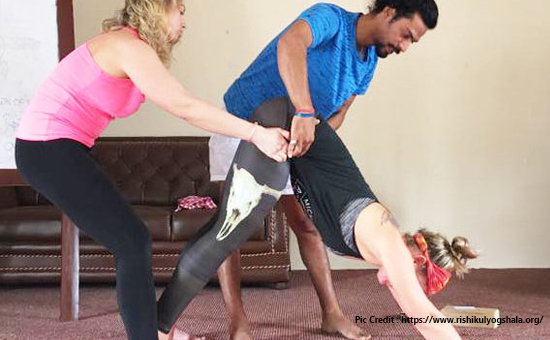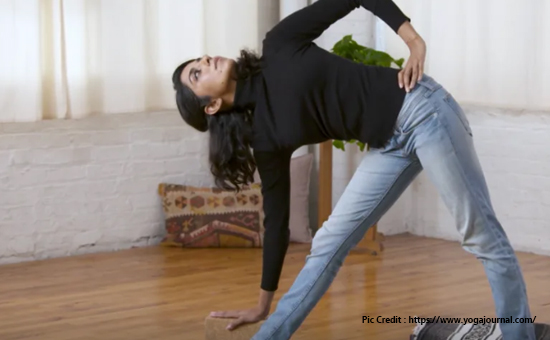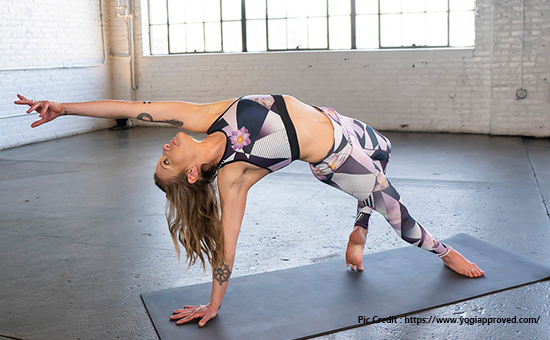- This articles explains the five types of Yoga prevalent worldwide including Yin Yoga in China and Acro Yoga in Vancouver.
The word Yoga comes from the Sanskrit word “Yuj” meaning union. In this context, it means a union of the body, mind, and soul. Thousands of years ago, yoga was written about in the Bhagavad-Gita, Yoga Sutras, amongst others.
Today, millions of people around the world practice this ancient art for
healing and spiritual growth. Yoga is a multiverse of its own. There are different
forms of yoga practiced worldwide.
Some people find a style of yoga and spend years diving steep in that
style and mastering it. Some people like to learn various styles of yoga and
form their unique style of yoga through that.
Yoga is India’s biggest export. Those making millions through Yoga do not pay royalty to India where Yog originated.
This article gives a brief write up on five types of yoga taught in
different countries:
HATHA YOGA

Hatha yoga is the oldest form of yoga and is one of the types of yoga
taught in different countries. All other forms of yoga have originated
from Hatha yoga. Being taught in many yoga retreats in India, Hatha yoga is one
of the most widely practiced forms of yoga.
Any practice you do with the body are considered the practices of Hatha yoga. Asanas - the yoga postures, pranayama – breath-work, mantra - chanting, mudras, shatkriyas - cleansing techniques, and various types of visualizations all fall under Hatha yoga. Mudra therapy is a subject by itself (see link at end of article).
Most people across the world practice yoga postures and breathing
exercises. The other practices of Hatha yoga are only practiced by advanced
yogis who have a certain level of mastery over themselves.
The Gheranda Samhita, which is a 17th-century sacred text on Hatha yoga,
describes that Hatha yoga consists of 6 cleansing methods, 32 asanas, atleast ten
pranayamas, and 25 mudras. A typical Hatha yoga sessions involves asanas,
pranayama and meditation.
Mysore and Kerala, both of which are located in south India are the best
destinations to learn and practice this ancient style of yoga called Hatha
Yoga.
ASHTANGA YOGA

Ashtanga yoga is the second oldest system of yoga recorded by the great
sage Vamana Rishi in the sacred text known as Yoga Korunta. This ancient text
has a list of many different groupings of asanas as well as other teachings of
yoga philosophy, bandhas, and much more.
“Ashtanga yoga is a system of yoga recorded by the sage Vamana
Rishi in the Yoga Korunta, an ancient manuscript "said to contain lists of many different groupings of asanas, as well as highly original teachings on vinyasa, drishti, bandhas, mudras, and philosophy" (Jois 2002 xv). The text of the Yoga Korunta "was imparted to Sri T. Krishnamacharya in the early 1900's by his Guru Rama Mohan Brahmachari, and was later passed down to Pattabhi Jois during the duration of his studies with Krishnamacharya, beginning in 1927" ("Ashtanga Yoga").” Source here
To read about T Krishnamacharya
B.K.S. Iyengar too learnt from Shri T Krishnamacharya. However, there
were differences between Iyengar and Ashtanga Yoga.
Ashtanga yoga is an 8-limbed path that has transformed the lives of
thousands of people around the world with its structured yoga asanas and breath-work.
The difference between Ashtanga and Hatha yoga is that Ashtanga is a
faster-paced yoga style, whereas Hatha yoga has a slower pace.
The asanas in Ashtanga yoga are held for a shorter duration unlike Hatha
Yoga where they are held for a longer duration. In Ashtanga, there is a flow of
asanas, whereas, in Hatha yoga, the asanas are practiced and experienced by holding
a static pose for a longer duration. Both forms of yoga are beneficial in their
own ways.
Ashtanga yoga is a more dynamic form of yoga, and you are sure to sweat
like never before when practicing Ashtanga, especially when you have just
started, and your body is getting adjusted to the dynamic asana movement.
Ashtanga yoga is about learning to move your body smoothly, artfully and
with force by focusing on the breath and the body simultaneously.
Mysore in India and Melbourne in Australia are some of the best places
to learn and practice Ashtanga Yoga. Ashtanga yoga retreats in India are
intensive and require a deep level of focus, dedication. They will strengthen
your core muscles like no other style of yoga.
YIN YOGA

In ancient Chinese philosophy, Yin and Yang are two opposite parts of
the whole. Yin is the feminine principle, and yang is the masculine principle.
Yin is the dark principle of life, and yang is the light principle of life.
Yin yoga is based on the yin principle combining ancient Chinese
philosophy with ancient Indian spirituality. Yin yoga, as the name suggests, is
a more feminine form of yoga, which is slow, gentle, and patient.
Hatha yoga and Ashtanga yoga fall under Yang yoga as both styles of yoga require us to apply force through our bodies. Yin yoga doesn’t require your force; in fact, it teaches asanas that are practiced through flow and surrender and not force.
Force and flow are both needed in our lives and to understand the nature
of life. Yin yoga brings in the flow and feminine aspect, which is about gently
allowing and surrendering to the movements of the body.
The focus of yin yoga is on the deep connective tissues between the
muscles and fascia throughout the body. In Yin yoga, each pose is gently held
for 45 seconds to 2 minutes, depending on the yoga practitioner and the flow of
their body.
One of the best types of yoga taught in different countries; yin yoga
helps to build intimacy with ourselves. Bali is one of the best destinations
for Yin yoga in the world.
ACRO YOGA (Acrobatics)

Until Acro yoga, yoga was all about you practicing alone on the mat. Enter Acro yoga, and now you don’t have to do it alone. Acro yoga is a sublime combination of yoga and acrobatics.
Yoga is about union of mind, body and soul. To that we add acrobatics.
By its very nature acrobatics requires another being lifted.
Acro yoga is the perfect form of yoga to develop kindness towards others
and trust in ourselves and others. Since it involves other people and often
involves lifting someone up in different angles and postures, it requires us to
have trust in ourselves - trust that we can genuinely hold someone with respect
and not let them fall.
Vancouver in Canada is one of the best destinations to practice Acro
yoga.
KUNDALINI YOGA

Kundalini is revered as the divine energy that lies dormant at the base
of the spine. Asanas, meditations, chanting mantras, mudras, breath-work are
all a part of Kundalini yoga and are practiced to awaken the Kundalini energy.
Kundalini yoga is not just about awakening the Kundalini, though. It is
much more than that.
We have three energy channels in our body - Ida, Pingla, and Sushumna.
One is the left energy channel known as Pingala; next is the right energy
channel known as Ida and the central energy channel known as Sushumna.
Kundalini yoga is about practicing the asanas and other practices to
raise the energy from the base of the spine through these energy channels. As
we raise the energy through the energy channels, our chakras, which are 7
energy centers in our body, start to purify.
As these energy centers start to purify through the right and left
energy channels, our energy starts to increase. Kundalini fully awakens when
the energy passes through the Sushumna Nadi, which is the central energy
channel.
Kundalini yoga should be practiced with precaution as the practices of
Kundalini yoga produce a lot of heat in the body, which results in an increase
in energy. We need to be responsible in how we use the energy that is produced
with Kundalini yoga.
No matter which style of yoga you practice, what is essential is that it
is practiced with dedication, sincerity, and respect for the teachers, for
yourself, and most importantly, for the practice. Practiced sincerely, no
matter which style you practice, it will lead you to healing and spiritual
growth that you seek.
Author Om Singh is a blogger at Retreat Kula. He is always on the lookout for interesting places to visit. It took him 25 years of his life to realize where his true calling lies, but once that was done, there’s been no looking back. He is a blogger at Retreat Kula, a website that offers the best platform for yogic lifestyle
Also read
1. Photos
of Yoga Asanas
2. Introduction
to Mudra Therapy
3. Read
about Yoga Rashya by T Krishnamacharya
4. List
of Institutions in Yoga where you can learn Yoga
5. Differences
between Ashtanga and Iyengar Yoga